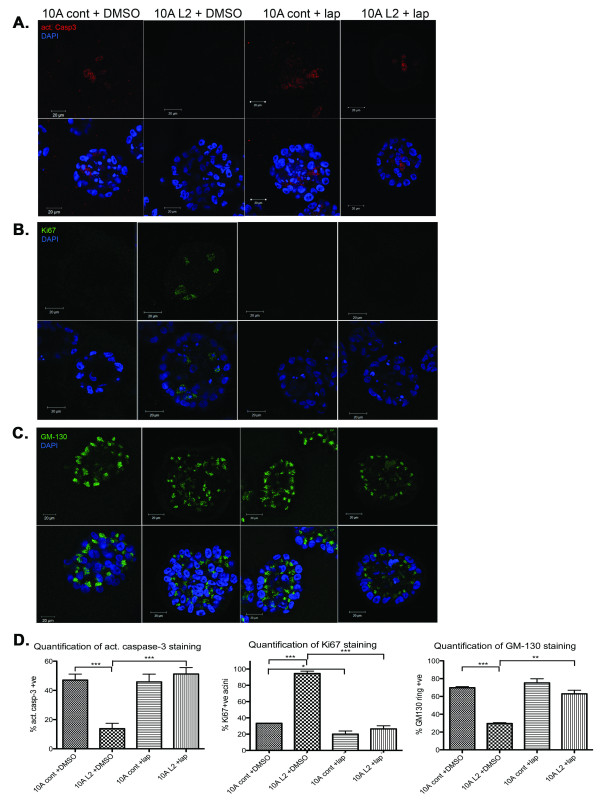Figure 5.
The dual ErbB1/ErbB2 inhibitor lapatinib reverts LOXL2-mediated acinar morphologic changes to a more-normal phenotype. Acini were cultured as described in Figure 2; 5 μM lapatinib (lap) dissolved in DMSO was added to cells at day 6 (10A cont+lap; 10A L2+lap), and equivalent amounts of DMSO were added as a control (10A cont+DMSO; 10A L2+DMSO). Acini were fixed, stained, and quantified as described. All data are based on at least three independent experimental repeats. Scale bar, 20 μm. (A) Immunofluorescence staining of acini with anti-activated caspase-3 antibody to detect apoptotic cells on day 8. Staining revealed increased activation of caspase-3 in 10A L2+lap acini when compared with 10A L2+DMSO acini. (B) Immunofluorescence staining of acini with anti-Ki67 antibody to detect proliferating cells on day 13. Staining revealed a decrease in proliferating cells in 10A L2+lap acini when compared with 10A L2+DMSO acini. (C) Immunofluorescence staining of acini with anti-GM130 antibody to assess cell polarity on day 10. Staining revealed GM-130 ring-like staining effect in 10A L2+lap acini, compared with the scrambled and disorganized staining observed in 10A L2+DMSO acini. (D) Quantitative analysis of activated caspase-3 staining (left panel; P = 0.00047 for 10A cont+DMSO and 10A L2+DMSO; P = 0.0006 for 10A L2 ± lap), Ki67 staining (middle panel; P = 0.00032 for 10A cont+DMSO and 10A L2+DMSO; P = 0.0257 for 10A cont ± lap; P = 0.00013 for 10A L2 ± lap), and GM130-ring structures (right panel. P = 0.00016 for 10A cont+DMSO and 10A L2+DMSO; P = 0.0013 for 10A L2 ± lap) in acini. These results suggest that lapatinib treatment of 10A L2 acini significantly reverted the acinar morphology to a more-normal phenotype.

